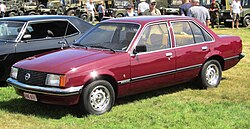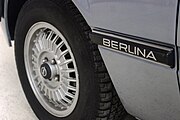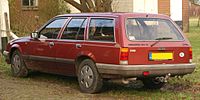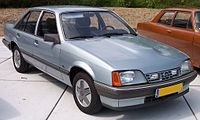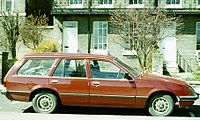Opel Rekord E.
| Opel | |
|---|---|
|
Opel Rekord (1977–1982)
|
|
| Record E | |
| Sales designation: | record |
| Production period: | 08 / 1977-06 / 1986 |
| Class : | upper middle class |
| Body versions : | Limousine , station wagon , panel van |
| Engines: |
Petrol engines : 1.7–2.2 liters (44–85 kW) Diesel engines : 2.1–2.3 liters (44–63 kW) |
| Length: | 4620-4678 mm |
| Width: | 1720-1726 mm |
| Height: | 1470 mm |
| Wheelbase : | 2668 mm |
| Empty weight : | 1145-1305 kg |
| Previous model | Opel Rekord D |
| successor | Opel Omega A |
The Opel Rekord E is a car of the upper middle class of Adam Opel AG , which in August 1977 as a successor to the Opel Rekord D was introduced. Like its predecessors was the type as station wagons (called by Opel traditionally "Caravan") available.
Until the facelift in October 1982, the model was called E1, then it was called E2. The platform of the Opel Rekord E was also used in the Opel Commodore C , Senator A and Monza A models.
The vehicle with a four-cylinder in - line engine , rigid rear axle and rear-wheel drive was the last representative of the Opel Rekord model series that had been available since spring 1953 .
After around 1.4 million vehicles were produced, the Rekord E was replaced by the Omega A in August 1986 .
Record E1 (1977–1982)
idea
Adam Opel AG presented the newly developed record at the IAA 1977. It partly adopted the technology of its predecessor. The Rekord E was a typical utility car with unexciting but reliable technology. Good middle-class driving performance, proper road holding and a somewhat unsatisfactory suspension comfort were, in addition to its pleasant appearance, characteristics of this series.
The large-scale series engines ( Opel CIH ) of the E1 model were available as 1.7 N (60 PS), 1.9 N (75 PS, regular gasoline), and three 2.0-liter versions 2.0 N (66 kW / 90 PS), 2.0 S (super petrol, 100 PS) and 2.0 E (injection, 110 PS) and a 2.1-liter diesel variant (60 PS), which after just one year was replaced by a version with 65 PS that was enlarged to 2.3 liters was replaced. In export there were z. B. For Italy, for tax reasons, a 2.0-liter diesel version with 58 hp, which was only offered in the Ascona B in Germany .
However, the small engines were rarely ordered, with a displacement of around two liters in this vehicle class. The diesel models with the characteristic hump on the bonnet were more in demand in Italy, the Benelux countries and France.
Equipment variants
There were three equipment lines:
- The record (basic model) as a two- or four-door sedan and as a three- or five-door caravan.
- The Rekord L as a two- and four-door sedan and as a five-door caravan.
- The Berlina record as a two- and four-door sedan and, from August 1980, also as a five-door caravan. The Berlina is the highest quality equipment.
There was an optional S package with z. B. light alloy wheels and a firmer chassis. A level control for the rear axle was available for an extra charge.
The interior was available in beige, red, blue or black. The window sills and dashboard tops were black. A darker shade of red was used in the Berlina , just like in the Senator / Monza.
Facelift
In July 1981, some model maintenance measures were carried out. All models now got a plastic spoiler at the bow, which the c w value dropped to 0.414; all sedans got rear lights with a black instead of a red plastic surround. The Rekord L was now called Rekord Luxus and had a “ Luxus ” lettering on the front fender, integrated exterior mirrors and, as a sedan, an extended rear bumper like the Senator, Monza and Commodore.
The Rekord Berlina also got these innovations, as well as a limousine from the Senator or Monza with wider side protection strips and rubber strips on the bumpers. The Berlina got the all-round chrome tail light strip from the Commodore ; the two-door record Berlina fell away. All models were available in new upholstery colors: beige, brown, dark green, dark blue or dark gray. The standard and luxury models have now been fitted with the same fabric. Velor was again reserved for the Berlina.
From April 1982 the sporty Rekord SR / E model appeared on the basis of the Rekord Luxus with a striking two-tone paintwork as a two- and four-door sedan and as a five-door caravan as a replacement for the S package.
Production of the Rekord E1 was ended in August 1982. It was followed by the E2.
Technical specifications
| Opel record: | 1.7 N | 1.9 N | 2.0 N | 2.0 S. | 2.0 E | 2.1 D | 2.3 D |
|---|---|---|---|---|---|---|---|
| Engine: | 4-cylinder in-line engine (four-stroke) | ||||||
| Displacement: | 1698 cc | 1897 cc | 1979 cc | 2068 cc | 2260 cc | ||
| Bore × stroke: | 88 x 69.8 mm | 93 x 69.8 mm | 95 x 69.8 mm | 88 × 85 mm | 92 × 85 mm | ||
| Performance at 1 / min: | 44 kW (60 hp) at 4800 |
55 kW (75 PS) at 4800 |
66 kW (90 PS) at 5200 |
74 kW (100 PS) at 5200 |
81 kW (110 PS) at 5400 |
44 kW (60 hp) at 4000 |
48 kW (65 hp) at 4200 |
| Max. Torque at 1 / min: | 112 Nm at 2600 | 132 Nm at 2800 | 142 Nm at 3400 | 165 Nm at 3600 | 159 Nm at 3000 | 118 Nm at 2500 | 126 Nm at 2500 |
| Compression: | 8.0: 1 | 7.9: 1 | 8.0: 1 | 9.0: 1 | 9.4: 1 | 22.0: 1 | 22.0: 1 |
| Mixture preparation: | 1 downdraft carburetor | 1 register downdraft carburetor | electronic injection (Bosch L-, from model year '82 LE-Jetronic) | Bosch diesel injection pump | |||
| Valve control: | Overhead valves, hydraulic valve lifters and rocker arms (overhead camshaft, duplex chain) | ||||||
| Cooling: | Water cooling | ||||||
| Transmission: | 4-speed gearbox, stick shift (a. W. (except 1.7 N) three-speed automatic (Opel)) | ||||||
| Front suspension: | MacPherson struts , tension struts, coil springs | ||||||
| Rear suspension: | Rigid axle on four trailing arms and Panhard rod , coil springs | ||||||
| Body: | Sheet steel, self-supporting | ||||||
| Track width front / rear: | 1435/1412 mm | ||||||
| Wheelbase: | 2668 mm | ||||||
| Length: | 4620 mm | ||||||
| Empty weight: | 1145-1370 kg | ||||||
| Top speed: | 143 km / h | 147–152 km / h | 157-162 km / h | 165-170 km / h | 171-176 km / h | 130-135 km / h | 132-137 km / h |
| 0-100 km / h: | 21.5 s | 17.5-19 s | 15-16.5 s | 13.5-15 s | 13-14.5 s | 26.5-31.5 s | 25-29 p |
| Consumption (liters / 100 kilometers): | 12.0 N | 12-13.0 N | 12.5-13.5 N | 12.5-13.5 S. | 12.5-13.5 S. | 10.0-10.5D | 10.5-11.0D |
Record E2 (1982–1986)
General
With the appearance of the revised E2 in October 1982, the body and the dashboard were revised. In addition to contemporary bumpers made of plastic, the record also received a higher rear end and a flattened bonnet with a new front section. Opel followed the currently popular wedge shape and was able to further reduce the drag coefficient to c w = 0.36 compared to the E1 .
The 1.7 N, 1.9 N and 2.0 N engines were no longer available and were replaced by the 1.6-liter OHC engines with cross-flow light-alloy cylinder heads that were first introduced in the Ascona C and Kadett D , here as the 1.8 N (55 kW) and 1.8 carburettor models S (66 kW). The 1.8 S-OHC engine made its debut in the Manta-B a few months earlier. The 2.0 CIH engines (S and E) were adopted unchanged.
The Rekord E2 was only available as a sedan with four doors, the base version of the caravan with three or five doors. The limousine in the Berlina equipment got a full-surface wheel cover. The green interior was omitted, as was the sporty variant SR / E.
A variant as a three-door delivery van with locked side windows was reserved for some export markets.
Facelift
In March 1983, the record CD was introduced as the new top model . It is based on the Rekord Berlina with a 2.0 electric motor. It can be recognized by an aluminum trim strip on the bonnet, sill panels and a new full-surface hubcap (design similar to that of the Ascona CD from the C series). The fine velor interior is also similar to that of the Ascona CD .
From model year 1984 the Rekord Caravan Berlina had the hubcaps known from the sedan, as well as a split foldable rear seat back. The simpler caravan models were also optionally available with this special equipment at an extra charge. The record caravan with CD equipment was new .
The diesel range was further expanded: The 2.3 D was increased to 71 hp in August 1983, and in 1984 the 86 hp turbo variant was added, which was also available in the Senator.
The innovations of model year 1985 are limited to changes in equipment. The lettering on the case lid was now made of plastic, the interior light was enlarged, and the new door panels were made without chrome. The equipment variants have been rearranged: the basic Rekord model has now become the Rekord LS , which now has full-surface wheel covers, new fabrics, a fold-out center armrest, a carpet-covered rear shelf as well as fabric-covered headrests and door panels and was therefore quite similar to the previous Rekord Luxus. The latter got a new high-quality velor interior similar to that of the previous Rekord Berlina and its wheel covers and was now called Rekord GL .
The Rekord Berlina became the Rekord GLS and was optically based on the Rekord CD with its fine velor interior, hubcaps and sill panels made of plastic. The record CD kept its name, it was now missing the trim strip on the bonnet and narrower tires were fitted as standard. In addition, there was the GLS Exclusiv towards the end of production .
The 2.0 E-motor was replaced in September 1984 by the 2.2i-Motor, which differs from the 2.0 E only by an 8 mm longer piston stroke . This engine is characterized by a particularly powerful acceleration even at low speeds. For some export markets, the 2.0 electric motor remained in the range due to different tax legislation.
Catalytic converter and ABS
From November 1984 the record was also available with ABS .
In August 1985 the catalytic converter variant "1.8 i" (C18NV), derived from the C18NE engine of the Kadett and Ascona, came onto the German market as one of the first exhaust-gas-cleaned vehicles.
End of production
In June 1986 the production of the last record E2 models was completed. In addition, after Kapitän (1970) and Admiral (1976), another great traditional name from Opel was dropped. The successor was called Omega from September 1986 .
Technical specifications
| Opel record: | 1.8 N | 1.8 S. | 1.8 i cat | 2.0 S. | 2.0 E | 2.2 i | 2.3 D | 2.3 TD | |
|---|---|---|---|---|---|---|---|---|---|
| Engine: | 4-cylinder in-line engine (four-stroke) | ||||||||
| Displacement: | 1796 cc | 1979 cc | 2197 cc | 2260 cc | |||||
| Bore × stroke: | 84.8 x 79.5 mm | 95 x 69.8 mm | 95 x 77.5 mm | 92 × 85 mm | |||||
| Performance at 1 / min: | 55 kW (75 PS) at 5400 |
66 kW (90 PS) at 5400 |
74 kW (100 PS) at 5600 |
74 kW (100 PS) at 5200 |
81 kW (110 PS) at 5400 |
85 kW (115 PS) at 4800 |
48–52 kW (65–73 hp) in the 4200–4400 |
63 kW (86 PS) at 4200 |
|
| Max. Torque at 1 / min: | 132 Nm at 3000 | 140 Nm at 3200 | 137 Nm at 3000 | 156 Nm at 3800 | 162 Nm at 3000 | 178 Nm at 2800 | 126-132 Nm at 2400-2500 | 185 Nm at 2200 | |
| Compression: | 8.2: 1 | 9.2: 1 | 8.9: 1 | 9.0: 1 | 9.4: 1 | 22.0: 1 | 23.0: 1 | ||
| Mixture preparation: | 1 downdraft carburetor | 1 register downdraft carburetor | electronic injection (Bosch LE-Jetronic) | 1 register downdraft carburetor | electronic injection (Bosch LE-Jetronic) | Bosch diesel distributor pump | |||
| Valve control: | Overhead valves, hydraulic valve lifters (overhead camshaft , toothed belt) | Overhead valves, hydraulic valve lifters (overhead camshaft, duplex chain) | |||||||
| Cooling: | Water cooling | ||||||||
| Transmission: | 4- or 5-speed gearbox, middle shift (on request (except 1.8 N) three-speed automatic (Opel)) |
5-speed gearbox, center shift | |||||||
| Front suspension: | MacPherson struts , tension struts, coil springs | ||||||||
| Rear suspension: | Rigid axle on four trailing arms and Panhard rod , coil springs | ||||||||
| Brakes: | Front disc brakes, Ø 244 mm, drums | ||||||||
| Body: | Sheet steel, self-supporting | ||||||||
| Track width front / rear: | 1435/1412 mm | ||||||||
| Wheelbase: | 2668 mm | ||||||||
| Length: | 4652 mm | ||||||||
| Empty weight: | 1140-1305 kg | ||||||||
| Top speed: | 154 km / h | 160-165 km / h | 167-177 km / h | 169-175 km / h | 175-181 km / h | 180-187 km / h | 145–153 km / h | 165 km / h | |
| 0-100 km / h: | 17.5 s | 15-16.5 s | 14-15.5 s | 13.5-15 s | 13-14.5 s | 12-13 s | 22-28 p | 16 s | |
| Consumption (liters / 100 kilometers): | 12.5 N | 12.5-13.5 S. | 13.0-14.5 S. | 12.5-13.5 S. | 12.5-13.5 S. | 12.5-13.5 S. | 10.5-11.0D | 10.0D | |
Export versions
In Great Britain the model was offered under the name Vauxhall Carlton from the end of 1978 .
This model differed externally from the Opel Rekord in the first series by a (then Vauxhall-typical) flat front section ("droopsnoot") similar to that of the Opel Manta B. From the end of 1982 (model E2) only the emblems and the right-hand drive were the essential distinguishing features, especially since the Carlton , like the record, was produced in the Rüsselsheim plant. In South Africa the Rekord E continued to be produced until 1990, at Daewoo it was offered as a Royale and from 1993 to 1999 with a revised body as a Prince or Brougham .
Web links
- Info page Opel Rekord E1
- Info page Opel Rekord E2
- Purchase advice Opel Rekord E
- Info page Opel Rekord E / Commodore C / Senator Monza A
Individual evidence
- ↑ a b c d e f g Eckhart Bartels, Rainer Manthey: Opel: Vehicle Chronicle Volume 2: 1952–1990. Podszun, Brilon 2012, ISBN 978-3861336204 , pp. 71/72, 78/79 and 93.
- ↑ Info page Opel Rekord E1, accessed on December 30, 2019.
- ↑ Info page Opel Rekord E2, accessed on December 30, 2019.
